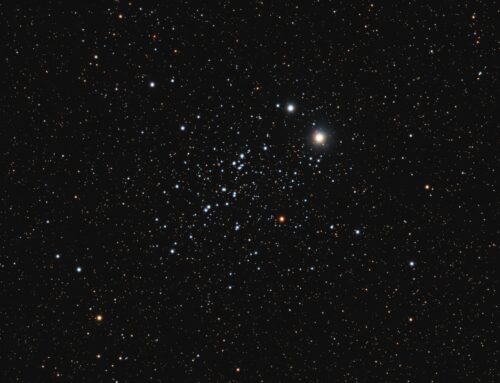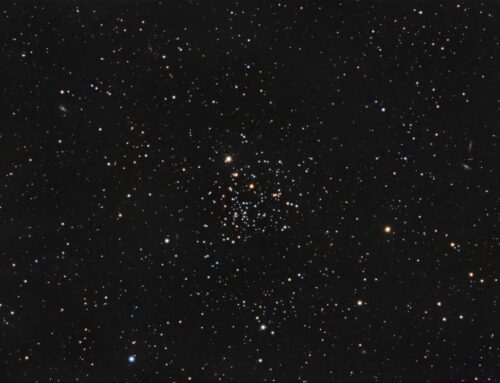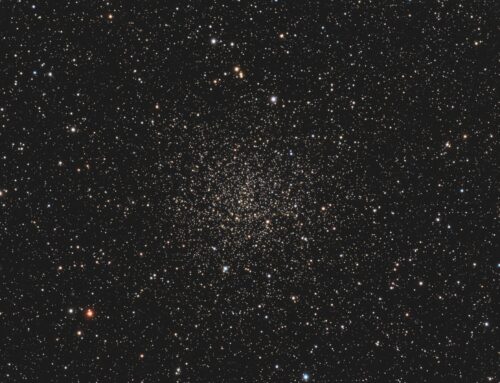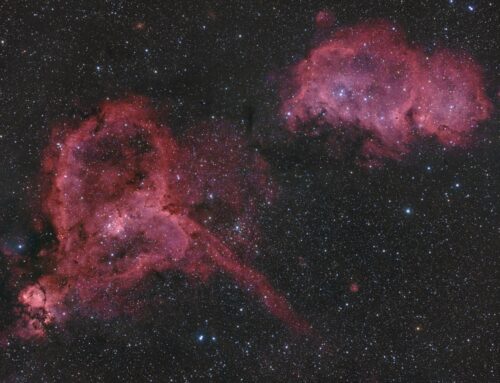Double Cluster
 Click image for full size version
Click image for full size version
I’ve imaged the Double Cluster with just about every different scope and camera that I’ve used. The Sky-Watcher Esprit 150 with the QHY-16200 camera really hits the sweet spot, getting the cluster well resolved in a nice frame.
NGC 869 (left) and NGC 884,each contain hundreds of stars and are about 13 million years old (compared to 75-150 million years for the Pleiades). Lying about 7,500 light years away and a few hundred light years apart, they have a combined mass about 6,500 times our Sun’s. However, their combined halo is more than 20,000 solar masses. The clusters are moving towards us at a speed of about 40 km/s.
These open clusters are bright enough that they were originally given star designations (h- and Chi Perseus). They are visible to the naked eye, appearing as an oval foggy patch in a dark sky. They look like sparkling white diamond dust in binoculars or a small telescope.
Tekkies:
Sky-Watcher Esprit 150 f/7 refractor, QHY 16200-A camera, Optolong L, R, G and B filters, Paramount MX. Acquisition with TheSkyX unguided. Focused with TheSkyX @Focus3. Automation with CCDCommander. All pre-processing and processing in PixInsight. Acquired from my SkyShed in Guelph. No moonlight, average transparency and average seeing. Data acquired October 9, 2018.
10x3m L, R, G and B (Total = 2hr).
Data Reduction and Cleanup
The BatchPreProcessing script was used to perform calibration, cosmetic correction and registration of all frames. ImageIntegration was used to create the L, R, G and B masters. DynamicCrop was used to crop all the masters identically. DynamicBackgroundExtraction was applied to each master.
RGB Creation and Processing
Creation and cleanup: ChannelCombination was used to make a colour image from the R, G and B masters. The RGB image was processed with PhotometricColorCalibration using a small preview of background sky as the background reference.
Linear Noise Reduction: MultiscaleLinearTransform was used to reduce noise in the RGB image. An internal mask was used, with layer settings for threshold and strength as follows: Layer 1: 3, 0.65 Layer 2: 2, 0.4 Layer 3: 2, 0.25 Layer 4: 1, 0.15.
Stretching: MaskedStretch was applied to the RGB image to make a pleasing, bright image. This was followed by brightness and contrast enhancement with HistogramTransformation and CurvesTransformation.
Synthetic Luminance
Creation and cleanup of SynthL: The L, R, G and B masters were combined using ImageIntegration (average, additive with scaling, noise evaluation, iterative K-sigma / biweight midvariance, no pixel rejection).
Linear Noise Reduction: MultiscaleLinearTransform was used to reduce noise in the SynthL image. An internal mask was used, with layer settings for threshold and strength as follows: Layer 1: 3, 0.5 Layer 2: 2, 0.35 Layer 3: 2, 0.2 Layer 4: 1, 0.1.
Stretching: HistogramTransformation was applied to the SynthL to make a pleasing, bright image.
Combining SynthL and RGB
The processed SynthL was applied to the RGB image using LRGBCombine.
Additional Processing
Nonlinear Noise Reduction: TGVDenoise was used in L*a*b* mode to reduce noise in the background areas.
Final Steps: Background and star brightness, contrast and saturation were adjusted in several iterations using CurvesTransformation with masks as required.
Image scale is about 1.15 arcsec per pixel for this camera/telescope combination.






Leave A Comment